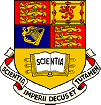
 |
|
News Page |

November 2000 |
This month's news stories:New Arrivals in SPATSPARC Meeting - Argentina Ulysses 10 Years on Saturn's Magnetic Field |
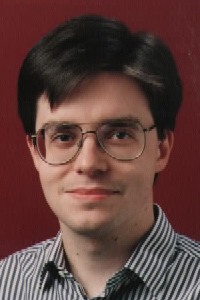 New arrivals in SPAT.....
New arrivals in SPAT.....Dr Tim Horbury recently returned to SPAT on 1st October after an absence of two years to take up a prestigious PPARC Advanced Fellowship. Here is how he introduces himself...
"I was born in Yorkshire, lived just south of Glasgow for a few years, but spent most of my formative years in a village south of Maidstone, in Kent, so although my accent is a bit odd, I'm a Southern boy at heart.
I've spent almost my whole academic life at Imperial: I did a Physics degree here, then my PhD in SPAT. I spent my PhD analysing Ulysses magnetic field data, concentrating on turbulence in the solar wind. After my PhD, I stayed in SPAT, spending 2 years as a PPARC Postdoctoral Fellow, then a year as an RA working again mostly on Ulysses data. I've just spent two years away from IC, at Queen Mary College which is in the East End, and now I've come back here as a PPARC Advanced Fellow. I'm still working on the Ulysses data, but mixed with lots of other things these days.
I live a highly domesticated life with my wife Antoneta, in Croydon, so my outside interests are things like ironing, washing up and going to the birthday parties of her nine nephews and nieces. We also try to blend in with the South London culture, so we watch films and have been known to go bowling."
 ...and 6 new Postgraduate Students
...and 6 new Postgraduate Students1st October also saw the arrival of six new students into the group - Jonathan Eastwood and Matt Owens in Space Physics, and Colin Cotter, Andrew Earis, Alessio Farhadi and Laila Read in Atmospheric Physics. Each of them have contributed a few words to introduce themselves...
Colin Cotter: Colin (pictured left) was born in Gottingen, W. Germany, and grew up in Woodbridge, Suffolk. He took his first degree in Maths. at Fitzwilliam College, Cambridge. His PhD supervisors here are Ralf Toumi (from SPAT) and Rupert Ford (from the Maths. Department). The topics of his research are dynamics, mixing and transport in the tropopause. Colin's outside interests are football (playing, and watching Ipswich Town), playing jazz on piano and guitar, folk music, watching stand-up comedy, cooking, history, bridge and travelling.
 |  |
Jonathan Eastwood (second right): "I come from Worcester, although I was born 22 (and a bit) years ago in Bury, Lancashire. I completed my undergraduate degree (MSci with a year in Europe) at Imperial College, and spent my third year abroad in Paris at the Ecole Superieure de Physique et Chimie Industrielles (ESPCI). My supervisor in the Space and Atmospheric Physics Group is André Balogh. My PhD research will be based on data from the recently launched Cluster II mission. Away from work, I enjoy singing in the college choir (which I also help to run,) and playing the odd game of football."
Alessio Farhadi (no picture yet!): "I was born and brought up in London and my undergraduate degree is in Theoretical Physics from Imperial. My PhD supervisors here are Prof D D Vvedensky (Condensed Matter Theory) and Dr Ralf Toumi (SPAT). My outside interests are football, bungee jumping and salsa dancing".
 | 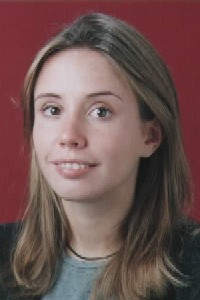 |
Laila Read (second left): "My original home town is Oslo, Norway. I spent the first eight years of my life there, before moving to a village near Norwich, in Norfolk. I lived there until I was sixteen, then returned to Sandvika (near Oslo) for two years, before coming to London. My undergraduate degree was an MSci in physics (with a year in Europe) here at Imperial. Prof John Harries is my supervisor and the title of my thesis is 'Analysis of Data from the New Earth Radiation Budget Experiments'. My outside interests include Kung Fu, skiing, reading, photography and travelling (learning about other cultures)".
Sue Balogh and Bob Forsyth 16th November 2000
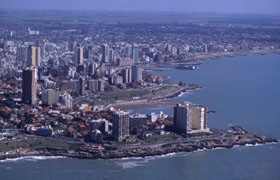 |
Mar del Plata |
From November 6th-10th 3 members of SPAT, Joanna Haigh, Vic Williams and Claire Smith attended the 2nd SPARC (Stratospheric Processes and their Role in Climate) General Assembly in Argentina. 250 scientists from 40 different countries gathered to discuss the impact of stratospheric physics, chemistry and their changes on the climate. The conference was held in the city of Mal der Plata, a seaside resort about 400km south of Buenos Aires. The venue, the Horizonte del Sol beach club provide excellent opportunities for strolls along the sand and swimming in the Atlantic Ocean (if you were willing to brave the cold!!)
Argentina was a particularly pertinent location for a conference on stratospheric issues because it is the most southerly inhabited country in the World and hence it's population will be one of the first affected by increased UV radiation should the springtime Antarctic ozone hole become any larger. This location also enabled many South American scientists to attend who find it difficult to be at conferences in the Northern hemisphere.
A wide range of subjects were covered in the scientific presentations with interesting discussions on many topics including variations in the temperature of the tropopause (implications for stratospheric water budget) and dynamical influences on mid-latitude ozone loss. A special public lecture was given by Nobel Laureate Paul Crutzen.
Jo Haigh gave an invited talk in the session on 'Modelling and Diagnosis of Stratospheric Effect on Climate' entitled 'The response of tropospheric climate to perturbations in the heat balance of the tropical lower stratosphere'. She discussed research done with Simon Ibbotson and Sami Djavidnia on the impact of solar UV and solar-induced stratospheric ozone variations using two different GCM's. Vic Williams was co-author with John Austin of the Met. Office of a poster entitled 'Model simulations of the impact of solar variability on stratospheric ozone and climate'. Claire Smith presented a poster in the 'Trends studies' subsession of the same session entitled 'Radiative Effects of Trends in Stratospheric Water derived from UARS HALOE'. This described work done with her supervisor, Jo Haigh and Ralf Toumi. Part of the research presented has been published and highlighted in GRL (see SPAT news, July 2000) and part has recently been accepted for publication, again by GRL.
The local organisers arranged an extensive schedule of social and cultural events to tie in with the local 'Tradition week' which ended with a national holiday, Tradition Day on Nov 10th. Highlights of the events included the conference dinner at a nearby country ranch where the conference participants were treated to a display of Argentine horsemanship by local 'Gauchos' and local folk dancing. A few nights later the opportunity to learn the national dance pastime was offered at the 'Tango dinner'. Success with the steps was varying but a lot of fun was had!!
Claire Smith, Jo Haigh and Vic Williams 15th November 2000
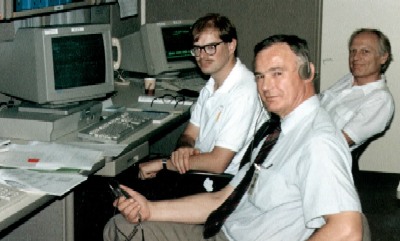 |
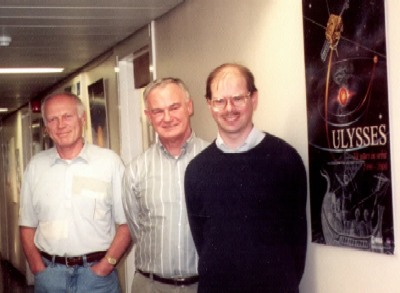 |
The Ulysses space mission, the first to visit the unexplored regions of space over the poles of the Sun, celebrated the 10th anniversary of its launch on 6 October 1990. Following the launch, a very important date for our group was 25 October 1990. On that day, the magnetometer, the instrument for which we are responsible on this mission, was switched on from the Ulysses Flight Control Room of the Jet Propulsion Laboratory, Pasadena, California. By that time, Ulysses was speeding on its way to Jupiter, so commands sent at the speed of light took more than a minute to reach the spacecraft from the ground, and then, after another, very long minute, our instrument responded: "All's well, let's measure magnetic fields!" Since then, the magnetometer has returned more than 300,000,000 measurements of the magnetic field in space along Ulysses' unique orbit. More than 300 scientific papers have been written by our team and collaborators in the past ten years on the many discoveries made by Ulysses.
The first of the accompanying photos shows the happy moment ten years ago when the magnetometer team received the first data back from Ulysses: André Balogh, Bob Forsyth and Trevor Beek look relieved that all was well on board. The second photo, ten years later, shows the same trio next to the poster celebrating Ulysses' anniversary. After all this time, even if we are bit older now, we remain just as excited about this mission as we were ten years ago!
André Balogh 15th November 2000
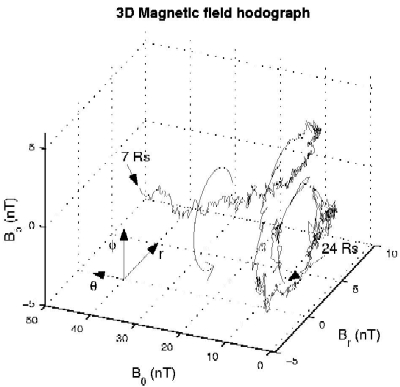
We are pleased to report the continued success of SPAT students in having papers specially picked out as highlights in the journal Geophysical Research Letters (GRL). The latest example is that of Stéphane Espinosa whose paper, written with his supervisor Michele Dougherty, entitled "Periodic perturbations in Saturn's magneric field" was highlighted in the September 1st issue.
The paper describes analysis of all the existing magnetic field data from Saturn's magnetosphere. These data arise from the three spacecraft encounters with Saturn (Pioneer 11, Voyager 1 and 2). In the cases of Pioneer 11 (whole encounter) and Voyager 2 (inbound) a surprising perturbation of a few nanoteslas is observed (with a period close to Saturn's rotation period). It is shown that a dipole tilt and/or current sheet crossings are unlikely causes for such periodic perturbations. This is in agreement with the negligible magnetic dipole tilt resulting from the existing models of Saturn's magnetic field.
The figure (click to enlarge) is a 3D hodograph of the vector magnetic field (planetocentric spherical polar coordinate system). This illustrates the helical perturbation measured outbound by Pioneer 11 between 7 and 24 Rs, that is over a period of around 23 hours or over two planetary rotations. The vector rotates anticlockwise around the minus 'theta' axis. The curved arrow indicates the direction of increasing time (the figure is from the follow-up article submitted to Advances in Space Research).
As one of the referees commented, 'The results are important because they challenge our understanding of Saturn's magnetospheric structure, and timely because they suggest features to be sought in the data from the Cassini orbiter now enroute to Saturn'.
The full reference of the paper is: Espinosa, S.A. and Dougherty, M.K., Periodic perturbations in Saturn's magnetic field, Geophys. Res. Lett., 27, 2785-2788, 2000.
Bob Forsyth and Stéphane Espinosa 16th November 2000
View Last month's news, older news or return to Space and Atmospheric Physics home page